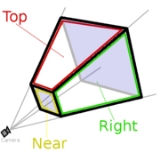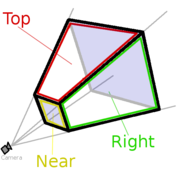
Viewing frustum
Encyclopedia

3D computer graphics
3D computer graphics are graphics that use a three-dimensional representation of geometric data that is stored in the computer for the purposes of performing calculations and rendering 2D images...
, the viewing frustum or view frustum is the region of space in the modeled world that may appear on the screen; it is the field of view of the notional camera. The exact shape of this region varies depending on what kind of camera lens is being simulated, but typically it is a frustum
Frustum
In geometry, a frustum is the portion of a solid that lies between two parallel planes cutting it....
of a rectangular pyramid (hence the name). The planes that cut the frustum perpendicular to the viewing direction are called the near plane and the far plane. Objects closer to the camera than the near plane or beyond the far plane are not drawn. Often, the far plane is placed infinitely far away from the camera so all objects within the frustum are drawn regardless of their distance from the camera.
Viewing frustum culling or view frustum culling is the process of removing objects that lie completely outside the viewing frustum from the rendering
Rendering (computer graphics)
Rendering is the process of generating an image from a model , by means of computer programs. A scene file contains objects in a strictly defined language or data structure; it would contain geometry, viewpoint, texture, lighting, and shading information as a description of the virtual scene...
process. Rendering these objects would be a waste of time since they are not directly visible. To make culling fast, it is usually done using bounding volume
Bounding volume
In computer graphics and computational geometry, a bounding volume for a set of objects is a closed volume that completely contains the union of the objects in the set. Bounding volumes are used to improve the efficiency of geometrical operations by using simple volumes to contain more complex...
s surrounding the objects rather than the objects themselves.
Definitions
VPN: the view-plane normal – a normalSurface normal
A surface normal, or simply normal, to a flat surface is a vector that is perpendicular to that surface. A normal to a non-flat surface at a point P on the surface is a vector perpendicular to the tangent plane to that surface at P. The word "normal" is also used as an adjective: a line normal to a...
to the view plane.
VUV: the view-up vector – the vector on the view plane that indicates the upward direction.
VRP: the viewing reference point – a point located on the view plane, and the origin of the VRC.
PRP: the projection reference point – the point where the image is projected from, for parallel projection, the PRP is at infinity.
VRC: the viewing-reference coordinate system.
In OpenGL
OpenGL
OpenGL is a standard specification defining a cross-language, cross-platform API for writing applications that produce 2D and 3D computer graphics. The interface consists of over 250 different function calls which can be used to draw complex three-dimensional scenes from simple primitives. OpenGL...
, the viewing frustum is commonly set with the gluPerspective (or glFrustum )utility function.
The geometry is defined by a field of view
Field of view
The field of view is the extent of the observable world that is seen at any given moment....
angle (in the 'y' direction), as well as an aspect ratio
Aspect ratio (image)
The aspect ratio of an image is the ratio of the width of the image to its height, expressed as two numbers separated by a colon. That is, for an x:y aspect ratio, no matter how big or small the image is, if the width is divided into x units of equal length and the height is measured using this...
. Further, a set of z-planes define the near and far bounds of the frustum.

